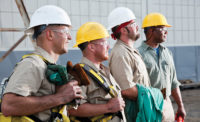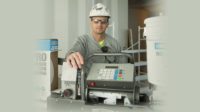Measuring Job Site Productivity

Productivity is measured based on output per labor hour. In drywall terms, it is the square footage amount one board hanger can hang in one hour. To measure productivity, one must know what the output per hour is, and in the case of drywall hanging most contractors look at it historically rather than currently.
In other words, contractors look at their job costs and see negative variances in the amount budgeted week after week, and month after month until the job is done. Once the job is done, they can say they did really well on the framing, OK on the taping, but the drywall hanging didn’t go so well.
The Magic of Thirds
I attended a magic club meeting recently and talked to professional magicians who have been in the business for 20, 30 and 50 years. They are the first people to tell you there is no such thing as magic, as all good magic requires a lot of hard work.
Combining framing, drywall and taping into one job cost is a great platform for creating illusions and distractions from any one category of work because most contractors look at the job cost from an overall perspective rather than individual. Overall, the job is doing pretty good, even though it looks like our hanging budget is going negative.
When you have a contract to frame, hang and tape, consider looking at it as three totally separate profit centers rather than one overall job. For example, let’s say you set up three separate job costs for each of the three work categories and you put three different managers in charge of each work category. Each manager of each work category is only responsible for the work his or her team performs.
One manager specializes in framing, another hanging and another taping knowing that their only purpose is to beat the output budgeted in their category of work. Specialization is not a new idea, as it is used in many industries. Think of it this way, can GM, Ford or Apple build every component they need as cost effectively as companies who specialize in providing the components needed to build a car or a phone?
Should a drywall contractor expect one manager to manage three highly specialized work categories? Well, of course, you say, because who in their right mind would want to add the additional overhead expense when you can have one person managing it all.
But what if you did it differently? What if each specialist managed his or her category of work on multiple jobs? What if every job had a framing, hanging, and taping manager specialist? What if each of these managing specialists had developed a production team for each work category that was the best of the best? What would the impact be if your company had managing specialists who had a talent following and a procedure process that was bar none the best of the best?
If you really want to win the productivity challenge, your plan must include some very unique ways of how work is managed and performed.
Assistive Technology and Averages
What if we developed specialized tools and equipment to assist board hangers? What kind of tool or piece of equipment would make their job safer, easier and faster? Tools that do these sorts of things are called assistive technology tools, such as screw guns, tape measures or man lifts.
No doubt these tools have made things a little safer, easier and faster, but not as safe, easy, or as fast as they could be. What could make the drywall hangers work safer, easier and faster than it is now?
How about an exoskeleton a worker can strap on each day that distributes weight better than the human body? When it comes to making the drywall hangers work easier, one might consider how to reduce the weight of drywall, its placement during stocking, its dimensions, and maybe how its cut. Remember, your plan can include ideas or concepts for tools and equipment that are not currently on the market. In other words, include tools or equipment of the future, but they have to be feasible possibilities.
Faster is an important factor and this is probably the missing link everyone would like to find, but maybe the solution to faster is safer and easier, and maybe it’s not. To win the challenge, each applicant’s plan must include an assistive technology plan that makes the drywall hangers work safer, easier and faster in order for your plan to be seriously considered.
To overcome the average worker problem is an interesting issue to consider. In this labor market, when you man your drywall projects you will have a combination of workers that include the most productive, as well as the average to below average producers. How will your plan or your assistive technology bring your average to below average workers to the most productive worker status?
Will your plan include motivational training for the average, or below average worker? How will you identify average to below average producers and how will your plan move them to most productive?
Schedule, Sequence, Manpower and Supervision
How a drywall hanger’s work is scheduled, sequenced, supervised using the least number of workers is key to achieving optimum productivity. Your plan must address how to overcome schedule, and sequence variations impacting productivity. Your plan must also address how you will achieve optimum number of workers and how you will supervise the optimum number of workers.
Your plan must also include how you intend to get owners and general contractors to buy in on schedule, sequence, manpower and supervision (SSMS) and how you will be compensated should scheduling or sequencing impact your productivity. The question is, how will your plan address the SSMS issue in order to achieve maximum productivity? Will you train your office and field staff to identify SSMS problems before they happen? Will you use some sort of software technology to help your employees identify SSMS problems before they happen or at the time it happens?
When a project’s schedule changes, it usually impacts the sequence of your work. Will your plan include a way to accurately calculate the exact amount of production lost, the additional number of workers and supervisors that will be added as a result of the change in schedule?
Breaking Down SSMS
- Schedule Changes > Impact Sequence-Impact Manpower-
- Impact Supervision
- Sequence > Impacts Manpower-Supervision
- Manpower > Impacts Productivity-Impacts Supervision
- Resulting In > Productivity Loss-Increased Supervision Costs
- Productivity Loss = Increased
- Labor Cost
- Increased Supervision = Increased Labor Cost
The judges will look very closely at how your plan will overcome this common productivity problem. How will you do it, how will you keep the original schedule on course, and if it goes off course at no fault of your own, how will you recover the costs? This all has to be addressed in the plan, and if it’s not, you won’t have a chance of winning.
Applicants-Format
The competition is open to everyone and anyone who wants to apply. To be considered, your plan must be in the following format:
- Table of Contents
- Maximum of 2 page Introduction
- Maximum of 2 page Production Plan Overview
- Maximum of 5 page Your Plan (details of your plan)
- Maximum 1 page of Originality Overview
- Maximum 1 page of Feasibility Overview
- Maximum 1 page of Receptivity Overview
- Maximum 1 page Closing Statement of why you thinkyour plan should be considered
Table of Contents
A simple table of contents is required referencing the page numbers for each section.
No More Than a 2 Page Introduction
Introduce yourself, company, contact information, job description and introduce your plan by briefly describing what problems your plan will solve.
No More Than a 2 Page Production Plan Overview
Describe the big picture of your plan not the details of your plan. In general, describe the key elements of your plan that might improve productivity specifically related to drywall installation.
No More Than a 5 Page Description of Your Plan
Describe in as much detail as you feel is necessary to explain the details of your plan from start to finish.
No More Than 1 Page on Originality
Explain what is so original about your plan. Is it a new process, procedure, technic, technology or piece of equipment? What makes your plan so original?
No More Than 1 Page on Feasibility
Explain the feasibility of your plan in achieving higher productivity in detail.
No More Than 1 Page on Receptivity
Explain what it will take to get employees on board with your plan. Will your plan be adopted easily or will your field staff reject it?
The Drywall Productivity Challenge
Enter to win this year’s $5,000 drywall hanging, productivity challenge.
Applicants must submit their drywall productivity plans no later than November 1, 2015. The winner of the plan competition will be announced on January 1, 2016.
Each plan will be judged on originality, feasibility and receptivity. Each category will be scored on a point system of 10 points for each category. The plans having the highest number of points will be deemed the winners. First Place will receive $3,000; Second Place and Third Place will receive $1,000.
Submit your plan to lewisl@bnpmedia.com. The judges for this competition are Mark Fowler, formerly the Vice President of Western Wall and Ceiling Contractors Association, and the current Editorial Director for Walls and Ceilings, and Exterior Consultant. Also, James Stafford, Technical Coordinator for Carpenters International Training Center, as well as myself.
Thank you to all of the sponsors for supporting this competition.
Originality
Judges will consider the uniqueness of the applicants plan. In other words, is the plan truly innovative or is it something the judges already know? To score a 10 in this category will require some truly inventive productivity methods that the judges have never heard of before.
Feasibility
Judges will consider the feasibility of each applicants plan. Meaning, the judges will determine on a scale of 1 to 10 how likely it is that the plan will result in higher productivity.
Receptivity
The highest scoring plans on originality and feasibility will be submitted to a sub-panel of judges made up of highly experienced drywall hanging foremen. These foremen will determine how well each plan will be received and implemented by drywall installers.
Looking for a reprint of this article?
From high-res PDFs to custom plaques, order your copy today!







